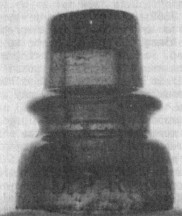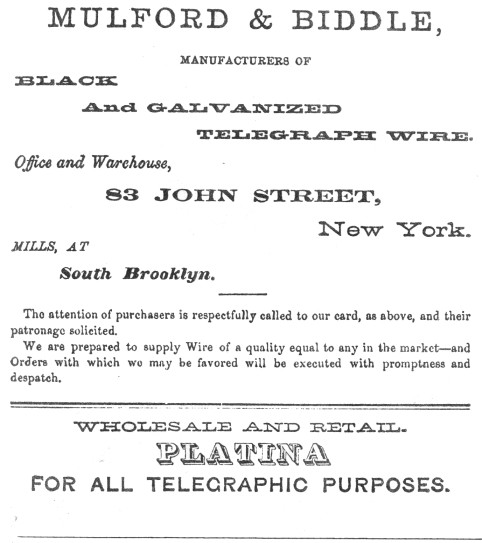"Threadless Corner"
by Ray Klingensmith
Reprinted from "INSULATORS - Crown Jewels of the Wire", January 1978, page 12
The UPRR
Welcome once again to "Threadless Corner". This month the featured item is the historic U.P.R.R. And history this insulator holds. Let's
start by giving a little background information on the railroad itself. In the
early years of our country, vast areas of land were uninhabited. As cities grew
larger, and population rose dramatically, our forefathers pushed westward. Many
settlers traveled as far west as California and other coastal regions. There
was, between the Mississippi Valley and the West Coast, a large tract of land
which was on the most part sparsely settled. As the west and east progressed
both financially and industrially, a link by rail was realized as being needed.
Several routes were proposed and surveyed. Finally in the 1850's some progress
was being made; but the outbreak of the Civil War halted most activity. A
company was formed, known as the Union Pacific Railroad Company.
The first
meeting was held in October, 1863. General John A. Dix was appointed as
president, and Thomas C. Durant as vice-president. In later years Durant became
the real driving force behind construction. On December 2, 1863, construction
officially got under way. The place: on the bank of the Missouri River at a
point where Omaha, Nebraska, and Council Bluffs, Iowa, face each other. These
were two "river towns", depending on the Missouri River for their
existence. Supplies were very limited for construction. The only real means of
transportation was the Missouri. The nearest railroad to Council Bluffs was over
100 miles away. So rails and ties were brought in from the east on river boats.
Grading had been going on for some time; but over one and a half years had gone
by before the first rails were laid.
In 1865 the Civil War ended. That's when
the big break finally came for construction. Iron rails, locomotives, ties and
other supplies were once again available. And the greatest of all resources was
in abundance -- men. Men from both the Union and Confederate armies went in droves
to Omaha looking for employment on the Union Pacific. One of these men was
Grenville M. Dodge. He was hired by Durant as chief engineer. Dodge was well
experienced in surveying and railroad construction. The two of them were
determined to get the job done.
Another company, the Central Pacific Railroad
Company, had been formed in California to lay the rails eastward until meeting
the U.P. at the Nevada line. By the close of 1865, rails were laid by the UPRR
40 miles into the Nebraska Territory. Construction progressed dramatically. When
the rails reached the 100th meridian of longitude, which was 247 miles from
Omaha, Durant decided to have a large celebration on the spot. Well known
personalities, reporters, politicians, writers and businessmen were all
invited. They traveled upriver on boats to Omaha, where they boarded U.P.
passenger cars and were taken by rail to the "end of track". Three
days were spent celebrating on the prairie. Durant had several shows staged,
including an Indian war dance, a surprise mock Indian raid, and a band concert; and on the last night, a 20 mile area of prairie grass was set on fire,
which awed the spectators.
By the end of 1866 the rails reached as far west as a
point near what is today North Platt, Nebraska. In reaching Cheyenne, Wyoming,
in the winter of 1867, a change had been made by the government.
Previously the Union Pacific and Central Pacific were to meet at the Nevada
line. Now, under new legislation, they were to build until they met, wherever
the point might be. And a race began. Both railroads wanted to have as much
mileage as possible. At that point there was no letup. Obstacles were many, and
they had to be overcome. Several tunnels and bridges were to be built. One of
the most awe-inspiring bridges was that over Dale Creek. It was 700 feet long
and 126 feet high at its highest point.
Men worked hard, most of the work being
done by hand, with a little aid by blasting. Westward these men pushed through
towns like Green River, Bear River City, Echo City, through Weber Canyon and
north of Salt Lake City, until finally it was decided to join the rails at
Promontory, Utah.
The day when the rails met, May 10, 1869, a large ceremony was
held, with officials from both railroads in abundance. The telegraph lines were
there also. They were put up alongside the track, being used for several
purposes of communication, including the ordering of supplies and reporting the
progress of construction, and were possibly responsible for saving Durant's
life It seems that two days before the rails were to be joined, workmen
demanding their back pay surrounded Durant's car and threatened to hold him
prisoner until they got their pay! Durant quickly telegraphed for $500,000 to
pay his men what he owed them for their five months of work. And the telegraph
played a historic role in the reporting of the laying of the final rail. As the
band played and everyone cheered, W. N. Shilling, who worked the telegraph from
a small table at trackside, reported to the nation all that was taking place. He
had a nationwide hookup, which was the first in our history. Excitement was
felt throughout the nation as everyone awaited the driving of the last spike.
| Omaha telegraph reported: |
TO
EVERYBODY; KEEP QUIET. WHEN THE LAST SPIKE IS DRIVEN... WE WILL SAY "DONE'.
DON'T BREAK THE CIRCUIT, BUT WATCH FOR THE BLOWS OF THE HAMMER. |
| Promontory telegraph: |
ALMOST READY.
HATS OFF. PRAYER IS BEING OFFERED.
|
| Chicago telegraph: |
WE UNDERSTAND. ALL ARE READY IN THE EAST.
|
| Promontory telegraph: |
ALL
READY NOW. THE SPIKE WILL SOON BE DRIVEN. THE SIGNAL WILL BE THREE DOTS FOR THE
COMMENCEMENT OF THE BLOWS. |
| Promontory telegraph: |
DOT. DOT. DOT. DONE. |
And so it was, what seemed like an endless job was now
completed, the birth of the first transcontinental railroad. There was still much
work to be done. Branch lines were to be built, bridges replaced, better
upgrading; but the important thing was that the east and west were joined
together.
Now that we have a little history on the railroad, let's get into
telegraph line insulation. As stated before, the telegraph lines followed the
progress of construction. It appears that more than one type of insulator was
used. At Promontory, where the rails joined, a ramshorn type "hook"
can be seen in photographs. There also appears to have been some type of
"concave skirt signal" or "compromise" style in the same
area. The one we are most familiar with, which is the one covered in this
article, is the CD 735 with MULFORD & BIDDLE on one side and UPRR on the
other. These seem to have been located at various points along the right-of-way. They have been
found in aqua and cobalt blue. The blue ones termed "cobalt" are a
little different than what most collectors associate as that color, mainly owing
to the fact that we are used to seeing the "cobalt" Hemingrays. The
UPRR's lean a little toward what I term sapphire blue; but whatever you call
them, they certainly are beautiful. I've seen the green Mulford & Biddles,
but can't recall any marked with the UPRR on the other side. If anyone has seen
a green UPRR, please let me know, and I'll confirm its existence in a future
article. These items have a threadless pinhole that's a little under the
standard one inch size.

Photo of an embossed CD 735 UPRR MULFORD & BIDDLE. This one is the
beautiful "cobalt" color. These seem to have been used at various areas on the
historic rail line that was built over 100 years ago. |
Mulford & Biddle was a manufacturer of telegraph
wire in New York City. (See their interesting ad on the following page of this
article.) As can be seen in their ad, they supplied "black" and
"galvanized" wire. In all probability they had a contract to supply
all the wire and materials to be used in the building of the UPRR telegraph line.
More than likely, the embossed MULFORD & BIDDLES were made on special
order by a glass house. It's very doubtful Mulford & Biddle actually made
any of these insulators themselves. These were molded in two-piece molds and
seem to be well made. They are very uniform and have very few flaws in the
glass. The embossing is well done and indicates the work of a skilled mold
maker. These embossed jewels seem to be getting much harder to locate. A
couple years ago there seemed to be a somewhat adequate supply of them; but as
time goes on they are becoming much scarcer. I feel the blue ones are especially
underrated in our hobby. They are scarce, and their color alone makes them a nice
addition to any collection. I feel in years to come, this is one item which will
quickly increase in value as more and more collectors appreciate their true
rarity and beauty.
Value your UPRR threadless highly, if you are fortunate
enough to own one. It has a lot of history behind it. It may have carried
Durant's message to send one half million dollars for the workers! Or it could
have been used in one of the many rip-roaring now extinct towns, such as Bear
River City, where on November 19, 1868, a mob attacked the town, burned the jail
and ransacked the newspaper office. It could have been used at the amazing Dale
Creek bridge, or near the bridge at Devil's Gate, where the bridge was battered
by rushing waters from heavy rains, this happening just a couple days in
advance of the ceremonies at Promontory. And of all things, the Union Pacific
officials were on the wrong side of the bridge! Or your insulator may have been
removed from the line by an Indian in an attempt to disrupt service, as they
frequently attempted such acts. Yes, the UPRR insulators have history, a lot
of it. May I suggest, if you don't have one, that maybe you move it closer to
the top of your want list.

If you want to further your research, I strongly suggest reading the book
"Westward To Promontory", which shows many photos during and
immediately after construction of the railroad. Many of these photos show sharp
views of the telegraph lines. The text is written by Barry Combs, American West
Publishing Co., publisher, 1969.
That's all for now. If you have any comments,
contact me at my address: 709 Rt. 322, East Orwell, Ohio 44034.
Next month -- the
Unembossed CD 732.
|
